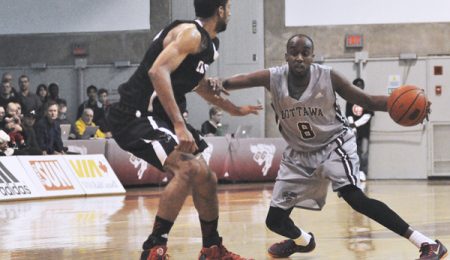Panelists explore need for diversity in newsrooms, sources
The Fulcrum hosted its first panel, focusing on the future of journalism, on Wednesday afternoon in Tabaret Hall.
The panellists were journalists in various beats of reporting, including the CBC’s Judy Trinh and Adrian Harewood, freelance journalists Haley Lewis and Susana Mas, and Huffington Post reporter Zi-Ann Lum.
Creating a diverse newsroom
Gabriela Perdomo, a PhD candidate at the University of Ottawa’s media studies program and moderator of the panel, kicked off the discussion by asking what diversity in the newsroom looks like and why the push for inclusion is important.
Harewood said it’s important for newsrooms to reflect the Canadian population so that all stories are told.
If not, “we’re not going to be serving our population, which we should,” said Harewood.
Harewood said diversity should go beyond entry-level positions of power up into higher levels of management, where decisions are made on what stories are being told and how they are being told.
“Within the CBC, there are a number of people who have been pushing the organization to recognize that it’s not adequate to just have people in front of the camera, but you also need people in decision making positions and you need people who are the veritable gatekeeper,” said Harewood.
Lum said not diversifying newsrooms not only hurts readers, but the newsroom itself.
“This push for more diversity in newsrooms is not new,” said Lum. “When I first came to journalism a decade ago, it was a common conversation that’s being talked about and it still is today. My views have shifted from anger to if certain leaders don’t do this at this point, they just do that at their own peril.”
“They’re not equipping their newsrooms in a way that will put them ahead of stories, on coverage,” added Lum. “If you don’t diversify your newsroom now, you’re going to put a mark on your coverage to come.”
Lewis said being the first Indigenous reporter at the Huffington Post went beyond representing a minority in the newsroom.
“It’s more than just reporting in the community, you become an advisor for the whole newsroom,” said Lewis. “It’s a lot of additional work of labour that you don’t really expect until you get into the position. It’s really important when you are in those positions.”
Mas said reporters can find ways to diversify their sources by spending more time finding a variety of voices.
“If you’re trying to find an expert — let’s say one of my beats is immigration — I make a point to find a female lawyer who can talk about this.”
Not only does it create better representation, but diverse reporters will find new angles on stories, said Lum.
Lum spoke about covering a press conference held by the RCMP about the awareness of phone scams that target the elderly. Pamphlets were produced in English and French, so Lum asked what the RCMP would be doing to inform people who don’t speak one of the official languages in their homes.
“The scams are disproportionately affecting seniors for they don’t usually speak English and French at home,” said Lum. “And so that was a question I asked and they didn’t really have an answer.”
Harewood quoted author Toni Morrison by saying “If you are free, you need to free someone else.”
“Whatever space you occupy could be at the university, it can be in the like the organization you’re in, it could be in the newsroom,” said Harewood. “Your job is to provide space for others.”
Overcoming barriers
For Lewis, representing a minority in the newsroom can come with additional challenges, such as financial barriers.
Lewis said unpaid internships are one of the barriers preventing many aspiring journalists from gaining experience to enter the field, let alone applying to journalism programs. Financial barriers are restricting young people who come from different economic backgrounds and classes from entering the field, she added.
“There are a lot of people that can’t afford to do those things,” said Lewis. “You really have to make sure that these people do have a chance because there are so many different voices that we’re just not hearing from.”
Trinh noted many reporters live near their newsrooms, typically located downtown. She said their daily life only interacts with what’s around them, creating a barrier of class when it comes to stories.
“In terms of my daily surroundings, there are literally shootings like a block or two away from me. I don’t look at (shootings) as just ‘targeted,’ ” said Trinh
“Sometimes there are so many resources devoted to Parliament Hill, and everyone’s devoting resources to the same story,” said Trinh. “Why do we need to run the same story with three or four different voices? Why don’t we say that we actually want to place national reporters out in the suburbs to look for a story.”
Trinh said power can also come from people going forward to journalists they trust. Trinh said the power of using Twitter and social media to call out or question issues people face in their lives is just as important, and reporters should be listening.
Harewood said the history and background behind journalism and journalists are important to include in the conversation of diversity.
“I’ve always felt that there’s no such thing as objectivity. I think that we all come from spaces, we all come from somewhere, and we all have perspectives. You can’t get away from that,” said Harewood. “We have to understand that the kind of newsroom ecosystem that we’re a part of is composed of many people who have very different views on the job and influences the kind of work that’s produced.”













